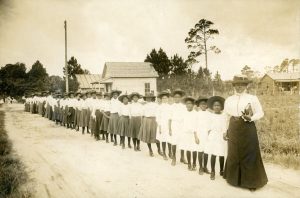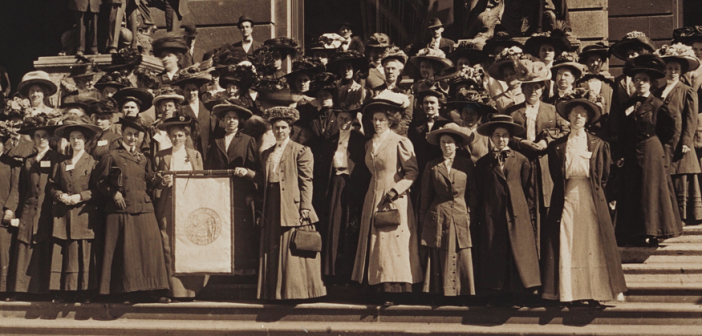
Educator and civil rights leader Mary McLeod Bethune, shown at far right with a group of children, circa 1905, was among those who fought to gain voting rights for Black people, who didn’t have voting rights until 1965 due to discrimination. (Image from Florida State Archives/public domain.)
The right to vote that American women hold today was only granted in recent history.
Labor union women were key to women gaining the right to vote after a fight that took 72 years. Black women also fought for voting rights, in a fight that took until 1965 due to discrimination. While fighting for the right to vote, Black suffragists also dealt with discrimination from some in the suffrage movement itself.
New Yorkers played a leading role in the suffrage fight, with early suffrage leaders Elizabeth Cady Stanton and Susan B. Anthony coming from respectively, Johnstown and Rochester. Later suffrage leaders such as Lucy Burns and Stanton’s daughter, Harriot Stanton Blatch, also had roots in New York.
The beginnings of the suffrage movement date back to 1848 with roots in Seneca Falls, N.Y. where the first Women’s Rights Convention was held and Stanton helped launch the decades-long fight.
The suffrage movement picked up steam in the later 19th century as support for women’s voting rights increased.
Labor unions had an important role in fighting for women’s suffrage. At the beginning of the women’s rights movement, many activists devoted to reform were middle and upper class women. Working women often had less time and funds to support social movements.
However, in the late 19th and early 20th centuries, that changed. Working women formed and joined labor unions to fight for fair pay and demand better working conditions. These women began to see that gaining the right to vote meant they would have more political power to further these causes.
Suffragists often recruited working women to support their movement. Blatch was among the first to reach out for their support. She began collaborating with the Women’s Trade Union League, which was founded in 1905 to help women form unions and advocate for fairer working conditions. In 1907, she founded the Women’s Political Union to bring more working women into the suffrage movement.
Suffragist leaders also adopted some of the same activism tactics commonly used by unions, including demonstrations and political action. Many suffragists faced violence, torture and imprisonment for their cause.
Many Black women were also key to women gaining the right to vote, although they faced discrimination from others in the suffrage movement, with reformers that included Josephine St. Pierre Ruffin and Charlotte Forten Grimke founding the National Association of Colored Women (NAWC) in 1898.
On Aug. 18, 1920, American women won the right to vote when the 19th amendment to the U.S. Constitution was ratified.
While the ratification of the 19th Amendment was a massive accomplishment for women’s rights, Black women would continue to fight for full voting rights for decades due to discrimination. Many states passed laws that discriminated against Black Americans and limited their freedoms.
These setbacks did not stop Black women from fighting for their rights. Government official and educator Mary McLeod Bethune became the founder and president of the National Council of Negro Women in 1935. Her goal to pursue civil rights for Black Americans, particularly women, was finally achieved when the Voting Rights Act was passed in 1965.
When remembering these brave women who were able to unite and fight for their rights to make political changes, it is easy to see the importance of getting out to vote.
It is essential that we use our right to vote, one that was so valiantly fought for, to make the changes we want to see in our government and in our communities.
— Grace Cross


